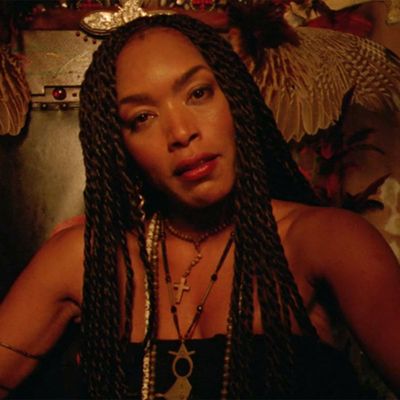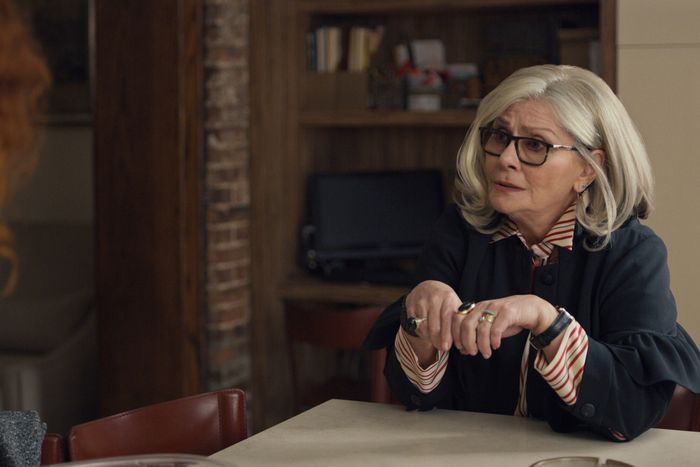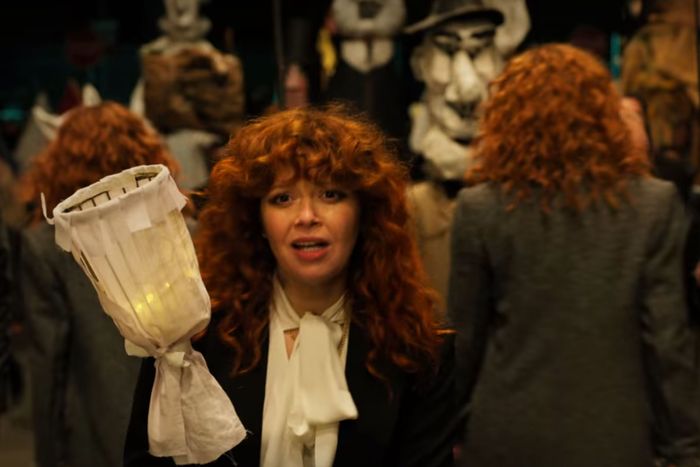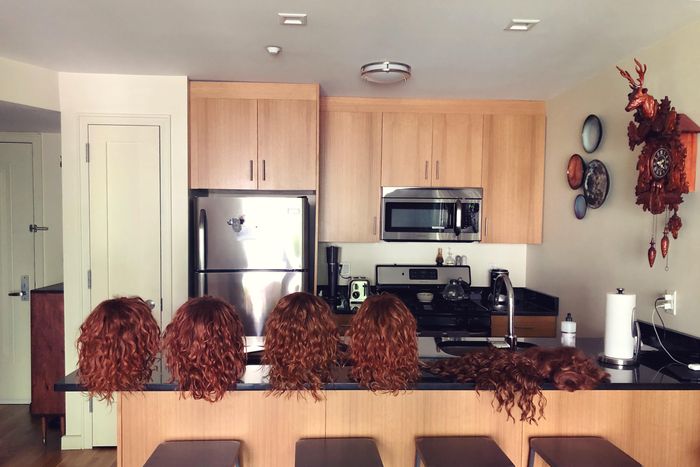
The breakout hair of Russian Doll was undoubtedly Natasha Lyonne’s curly red mop. It was her own hair colored red for the production, and several wig versions of it were put onto stunt doubles and then sent tumbling down staircases, flying through the air after being hit by cars, and walking past other versions of itself over the course of the series. In spite of the success of Lyonne’s hairstyle, though, it is not the thing Russian Doll hair stylist Marcel Dagenais is most proud of in the production.
“Amy Poehler [a showrunner on Russian Doll] at the premiere came up to me and said, ‘Aren’t you so proud of Natasha’s hair?’ And I said, ‘Absolutely, but I’m so proud of Ruth’s hair!’,” says Dagenais, referring to the platinum-grey bob worn by Elizabeth Ashley’s character. “That wig looked so real!”
This is the best-case scenario for many of TV’s best wigs: that they are never recognized for what they are. In most cases, a wig that any viewer realizes is a wig is a failed wig, and TV is full of wigs that look much, much too wiggy. But the reason bad wigs are so easy to find is that good wigs are so hard to pull off. They are expensive, time-consuming, and finicky. They can present just as many challenges several years into a production as they can right when that production starts. They have to withstand all kinds of shooting challenges — wrestling, tumbling, hair-pulling. And they almost always cause problems along the hairline. Bad wigs on TV are so prevalent because good wigs are exercises in endless patience, minute attention to detail, and massive budgets. Really great wigs are akin to miracles.
Part of that comes down to cost, because the easiest way to get a really great wig is to have it made custom for whoever’s wearing it. Custom wigs involve taking a mold of the actor’s head, tracing their hairlines, and taking lots of photos so that the wigmaker can mimic that person’s hairline as closely as possible. But custom wigs are huge line items on a budget. Michelle Ceglia, the hairstylist for American Horror Story, says that custom wigs “can be anywhere from $6,000 to $25,000”; GLOW’s hairstylist Theresa Rivers puts the cost for a custom wig at “anywhere between $8,000 and $15,000,” adding that wig pricing depends significantly on factors like length and color.
For many productions, though, the cost of custom wigs is prohibitive, and sometimes even if a production was able to devote the budget for a custom wig, it would not be able to wait the several weeks it might take to get a wig back from the wigmaker. Budget issues are particularly challenging on shows with much smaller overall budgets or that employ stunt doubles, who almost always need wigs so they can be swapped in for the actors they’re doubling. An identical hairstyle can be crucial to making a stunt double’s look feel plausible and persuasive, but it can be hard for productions to justify spending many thousands of dollars on wigs when they’re only seen in a few glancing moments on a stunt double’s head.
“I’ve seen a lot of stunt wigs that aren’t that great,” Rivers says, but on GLOW, “it’s very important for us to have those wigs be pretty much perfect.” For Rivers, that means devoting significant time and thought to how she can make each stunt wig approximate the look and fit of a bespoke wig.
“It’s not like I had custom wigs made for the stunt doubles,” she explains. “Well in advance of starting our show, I knew stunt wigs were going to be needed on a regular basis.” In the case of Alison Brie’s character Ruth, “the wig was $1,200, and then I permed it, and colored and cut it.”
Stunt-double wigs also play a prominent role on Russian Doll, where Natasha Lyonne’s character Nadia is regularly killed by, say, being hit by a car or flying head over heels into an open cellar door. Dagenais knew he’d need several wigs that matched Lyonne’s hair, both in curl and in the red color they’d chosen for her look.
“She has such a distinct head of hair,” he says. “I couldn’t just go to a wig store and pick out a wig.” Plus, all of the stunt wigs “had to be human [hair], because I had to color them.” Dagenais has a few wigmakers he works with regularly for shows with comparatively small budgets (Dagenais’s other work includes Search Party and Broad City). “I have one in particular [and] he made me a deal. I think I talked him down to $300 or $400 apiece, and generally wigs can go for $10,000. So to get that many wigs for under three grand … was a pretty good steal.”
Even with human-hair wigs in hand, though, the process of making those wigs match Lyonne’s hair still required Dagenais to cut, color, and style each one, a process that he says takes about four days, and that he does as “a conveyor belt of wigs lined up in my kitchen.” And because each individual wig is made up of several different human-hair sources, the coloring process is especially time-consuming. “With each wig,” Dagenais explains, “it’s multiple heads of hair in one wig.” Making a great Russian Doll wig is about “trying to match these red colors on hairs that each take color differently.”
At least the stunt wigs on Russian Doll didn’t have to address hairline issues, which are so often the challenge in great wig work. Because Lyonne’s long fringe obscures her hairline, Dagenais didn’t have to worry as much about that element of fitting. But for many hairstyles, hairlines become the dead giveaway for a rushed or ill-fitting wig. Even high-quality wigs with lace fronts designed to blended into the scalp often have hairlines that are too blunt, or that don’t match enough of an actor’s own natural hairline. In the case of GLOW, the wig for Alison Brie’s double when she plays wrestler Zoya the Destroyer is very tricky, because of Zoya’s vertical mohawk look.
“We have a stunt double who’s blonde, but the wig is brunette,” Rivers explains. “You can end up having blonde coming out from under the wig where you don’t want it. Disguising the lace is a lot of tucking and pinning, using an illustrator palette [a professional makeup palette] to paint in the blonde hair to match the wigs.” Ceglia has even resorted to using Nair on wigs, so she can remove bits that stick out too far and soften hard corners.
Even when productions do use custom wigs, or when a stock wig has been modified so that it perfectly fits an actor, vagaries of production scheduling can still make wig work wildly difficult. Ceglia recalls a period during the filming of the most recent season of American Horror Story when she was informed at the last possible moment that Angela Bassett would be returning later that week as Marie Laveau, a character from earlier seasons of the show who wears a massive wig. “And I’m like, ‘Marie Laveau! We don’t have that anymore! That’s like a 50-pound wig that goes down past her butt!’” Ceglia remembers. “Everything goes into storage, and sometimes things just can’t be located.” Ceglia had to get in touch with Bassett’s own hairstylist, who then helped Ceglia find different wigmakers who worked unbelievably hard to make sure Bassett had Laveau hair by the time she appeared on set. “Those poor women had to stay up all night to get us the look,” Ceglia says. It’s a challenge that happens frequently on Horror Story, where characters from previous seasons return unexpectedly, fit in wherever the production can manage when actors’ schedules make them available. “It’s always last minute,” Ceglia explains.
The frustrating paradox of so much TV hair is that some of a hairstylist’s best work might never be noticed by most viewers, since the most impressive TV wigs are often the ones that feel most invisible. It’s why Dagenais’s favorite wig from Russian Doll is actually the one worn by Elizabeth Ashley, who plays Nadia’s godmother, Ruth. Ashley was insistent that the wig be perfect. “She put the fear of God into me,” Dagenais recalls. “My whole mission was to make her love her wig.” But it’s very hard to find stock wigs made of gray human hair. There are synthetic options, but Dagenais finds them too shiny for a main character. Grey wigs can be made custom, but it was going to be too expensive for Russian Doll. “So I took a platinum-blonde wig and figured out a color formula to make this gray color that looked good,” Dagenais says
On the other hand, sometimes a TV wig is supposed to be visible. On GLOW, for instance, many characters wear wigs when they dress as their wrestler alter egos, and Rivers knows those wigs need to be true to what the characters would’ve been able to buy for themselves in the ’80s. Those wigs are cheaper, but just as much thought and work goes into the design and look of them in order to sell the character. Take GLOW’s Sheila the She Wolf. “When I came up with the look for her,” Rivers says, “I considered what kind of wig she would’ve purchased at that time.” It would not have matched the hairline, and it would not have been painstakingly color formulated. “This is someone who isn’t a hairdresser, but who wants to look like a wolf.”
The decision about whether to use a wig or to use an actor’s natural hair often comes down to practicalities — questions like production scheduling and budgets — but it is primarily a question of character. What would this character’s hair look like? What does it need to communicate about who they are? Sometimes, as in the case of Sheila, a wig really needs to look like a wig. But for most characters, as Ceglia explains, “regardless of what the character looks like and no matter what it might be, the goal is to make it look like it grew out of their head.” For most cases, in other words, the goal of the best TV wigs is that no one ever knows they exist.





